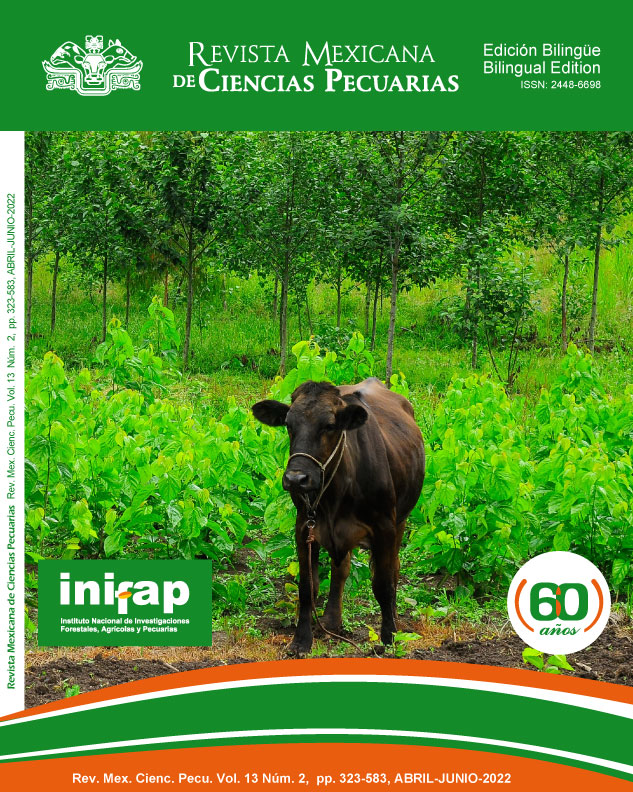Pharmacokinetic analysis of intraarticular injection of insulin and its effect on IGF-1 expression in synovial fluid of healthy horses
DOI:
https://doi.org/10.22319/rmcp.v13i2.5942Palabras clave:
Insulin, Intraarticular, Horse, IGF-1, HPLCResumen
Insulin induces mitosis on equine chondrocytes in vitro and enhances production of type II collagen. Insulin, when administered intra-articularly, changes the composition of synovial fluid, including the concentrations of glucose, insulin and glycemia levels. The concentration of insulin in the joint was measured by using high-performance liquid chromatography (HPLC), which provided pharmacokinetic values. Six mixed breed horses were administered three different doses of insulin into one antebrachiocarpal joint (10, 15 and 20 IU) and isotonic saline was administered into the contralateral joint. The blood glucose concentration significantly changed through time for all three doses (P<0.0001). No significant differences in protein concentration and cell count in synovial fluid were found between treated and control joints (P>0.05), no significant difference in synovial glucose concentrations was found between treated and control joints (P>0.05). Values obtained by HPLC analyzed with PkAnalyst program revealed that the pharmacokinetic values were dose dependent, there was no significant difference in concentration of blood glucose between the three different doses (P>0.05). ELISA for IGF-1 (insulin-like growth factor 1) revealed a significant difference between treated and control joints (P<0.001). Insulin used in this study proved to be innocuous to the equine joint, no more than 20 IU for a 350-400 kg horse should be administered.
Descargas
Citas
Celeste C, Ionescu M, Poole RA. Repeated intra-articular injections of triamcinolone acetonide alter cartilage matrix metabolism measured by biomarkers in synovial fluid. J Orthop Res 2005;(23):602-610. doi: 10.1016/j.orthres.2004.10.003.
Gotoh S, Onaya J, Abe M, Miyazaki K, Hamai A, Horie K, Tokuyasu K. Effects of the molecular weight of hyaluronic acid and its action mechanisms on experimental joint pain in rats. Ann Rheum Dis 1993;(52):817-822. doi: 10.1136/ard.52.11.817.
Henson FMD, Davenport C, Butler L, Moran I, Shingleton WD, Jeffcott LB, Schofield PN. Effects of insulin and insulin-like growth factors I and II on the growth of equine fetal and neonatal chondrocytes. Eq Vet J 1997;(29):441-447. doi: 10.1111/j.2042-3306.1997.tb03156.x.
Schumacher HR. Aspiration and injection therapies for joints. Arthitis Rheumatol 2003;(49):413-420. doi: 10.1002/art.11056.
Davenport C, Boston R, Richardson DW. Effects of insulin-like growth factor-II on the mitogenic and metabolic activities of equine articular cartilage with and without interleukin 1-β. Am Vet Res 2004;(65):238-244. doi: 10.2460/ajvr.2004.65.238.
Henneke DR, Potter GD, Kreider JL, Yeates BF. Relationship between condition score, physical measurements and body fat percentage in mares. Eq Vet J 1983;15,371-372. doi: 10.1111/j.2042-3306.1983.tb01826.x
Frank N. Equine metabolic syndrome. Vet Clin North Am Equine Pract 2011;(27):73-92. doi: 10.1016/j.cveq.2010.12.004.
Smith JS, Ratzlaff MH, Grant BD, Frank FL. The synovial fluid volume of the radiocarpal, intercarpal and tibiotarsal joints of a horse. J Eq Med Surg 1979;(3):479-483.
Moyer W, Schumacher J. A guide to equine joint and regional anesthesia. 4th ed . USA: Academic Veterinary Solutions, LLC; 2007.
Mahmood I. Naive pooled-data approach for pharmacokinetic studies in pediatrics with a very small sample size. Am J Ther 2014;(21):269-74. doi:10.1097/MJT.0b013e31824ddee3.
Hafiz Mohd MJ, Affandi MMR, Ah K, Sepria L. A simple and sensitive method for the determination of insulin in rat plasma and its application in pharmacokinetic study. Int J Pharm Pharm Sci 2013;(5):133-137.
Meyer DJ, Harvey JW. Evaluations of fluids: Effusions, synovial fluid, cerebrospinal fluid. In Veterinary laboratory medicine interpretation and diagnosis. 3rd ed. Saunders, USA. 2004;245-250.
Carter RA, Geor RJ, Burton SW, Cubbit TA, Harris PA. Apparent adiposity assessed by standardized scoring systems and morphometric measurements in horses and ponies. Vet J 2009;(179):204-210. doi: 10.1016/j.tvjl.2008.02.029.
Bertone AL, Cohen JM. Infectious arthritis and fungal infections arthritis. In: Ross MW, Dyson SJ. Diagnosis and management of lameness in the horse. 2nd ed. USA: Saunders; 2011;677-687.
Olds AM, Stewart AA, Freeman DE, Schaeffer DJ. Evaluation of the rate of development of septic arthritis after elective arthroscopy in horses: 7 cases. J Am Vet Med Ass 2006;(229):1949-1954. doi: 10.2460/javma.229.12.1949.
Adams SB. How to avoid complications following joint injections I: Site preparation and selection of needles. AAEP Proc. 2012;58.
Taylor FG, Hillyer MH. Enfermedades musculoesqueléticas. In: Taylor FG, Hillyer MH. Técnicas diagnósticas en medicina equina. Aribia, España. 1997;245-284.
Fortier LA, Strauss EJ, Cole BJ. The role of growth factors in cartilage repair. Clin Orthop Relat Res 2011;(469):2706-2715. doi: 10.1007/s11999-011-1857-3.
Yun CH, Tang YH, Feng YM, An XM, Chang WR, Liang DC. 1.42 Å crystal structure of mini-IGF-1(2): an analysis of the disulfide isomerization property and receptor binding property of IGF-1 based on the three-dimensional structure. Biochem Biophys Res Commun 2005;(326):52-59. doi: 10.1016/j.bbrc.2004.10.203
National Center for Biotechnology information database. 2020. https://www.ncbi.nlm.nih.gov/ .
Descargas
Publicado
Cómo citar
-
Resumen575
-
PDF 281
-
PDF303
-
Full text 325
Número
Sección
Licencia
Los autores/as que publiquen en la Revista Mexicana de Ciencias Pecuarias aceptan las siguientes condiciones:
De acuerdo con la legislación de derechos de autor, la Revista Mexicana de Ciencias Pecuarias reconoce y respeta el derecho moral de los autores/as, así como la titularidad del derecho patrimonial, el cual será cedido a la revista para su difusión en acceso abierto.

Esta obra está bajo una Licencia Creative Commons Atribución-NoComercial-CompartirIgual 4.0 Internacional.




